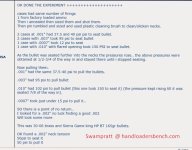Over the years of reloading the definition of Neck Tension seems to have no real definition!
The other day I was helping a friend with reloading and his thought was {see attached Pictures} was .0015 tension because you only count one side! I said its actually .003
I explained to him It is the outside diameter of bullet compared with inside diameter of sized brass. he then asked the difference between light neck tension and heavy neck tension?
Here's where it get good!
you know when you get caught with your hand in the cookie jar! and you know it might not be the right answer but it what you go with!
Light tension .002 or less
Med tension .002 to .005
Heavy tension .005 and up
So here is the question?
1: What do you say the pictures shows? .003 or .0015?
2: Is that a good definition of neck tension or not?
The other day I was helping a friend with reloading and his thought was {see attached Pictures} was .0015 tension because you only count one side! I said its actually .003
I explained to him It is the outside diameter of bullet compared with inside diameter of sized brass. he then asked the difference between light neck tension and heavy neck tension?
Here's where it get good!
you know when you get caught with your hand in the cookie jar! and you know it might not be the right answer but it what you go with!
Light tension .002 or less
Med tension .002 to .005
Heavy tension .005 and up
So here is the question?
1: What do you say the pictures shows? .003 or .0015?
2: Is that a good definition of neck tension or not?




